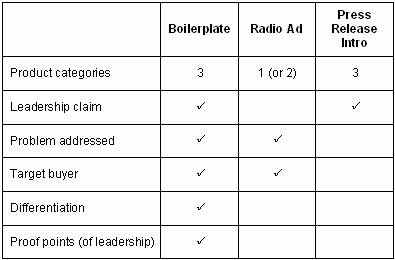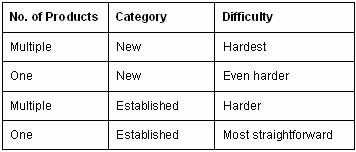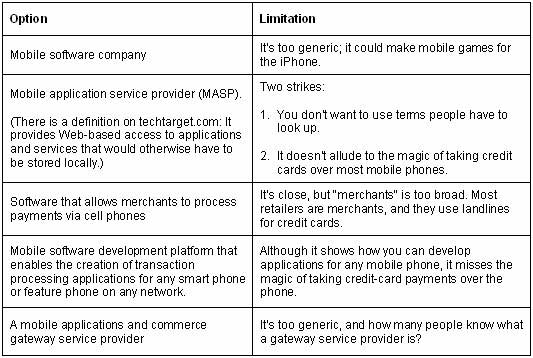Let's assume that your press release gets picked up by several outlets. It's a great opportunity to increase your company's visibility. So what do you say in your 15-word introduction? "XYZ, a ___ __ ___ ___ __ ___ ___ __ ___ ___ ___ __, announced today..." Would that resonate with your prospects?
Another scenario: One of your happier clients is at a barbecue listening to another guest describe a business challenge that sounds like the one you just solved for her. What easy-to-remember message have you provided your client to use in a situation like that?
Or let's assume you decide to sponsor an NPR program, and you draft a 10- or 15-second message to be read. What do you say? "All Things Considered is sponsored by XYZ. ___ __ ___ ___ __ ___ ___ __ ___ ___ ___ __ at XYZ.com" Is what you say clear and succinct enough that your prospects can absorb it while driving?
If people started with those scenarios in mind when they crafted their short company description, they would craft more concise and more memorable descriptions.
Now, as a B2B company, you may never advertise on NPR (though some do), but distilling your company description to its essence—as if you were—is a powerful goal. It will force you to jettison the jargon and superlatives. And your message will resonate all the more with prospects.
An Anatomy of a Company's Messaging
Here are two versions of Constant Contact's NPR sponsorship statement:
- 10 seconds: Constant Contact, dedicated to helping small businesses and nonprofits build strong customer relationships with email marketing. Constant Contact dot com.
- 15 seconds: Constant Contact, dedicated to helping small businesses and nonprofits build strong customer relationships with email marketing and online surveys. Constant Contact dot com.
Those versions total 20 and 23 words, respectively, or 14 and 17 words, respectively, if you exclude the company name and "dot com."
Here's what the company uses in the lead line (12 words, excluding the company name) of its press releases: "Constant Contact, a leading provider of email marketing, event marketing and online survey tools."
And in the boilerplate at the bottom of the press release, the company goes hog wild—using more than 80 words:
With more than 300,000 customers, Constant Contact, Inc. is a leading provider of email marketing, event marketing and online survey tools for small businesses, non-profits, and member associations. Founded in 1995, Constant Contact helps small organizations grow stronger customer relationships by delivering professional, low cost, easy-to-use online tools backed with award-winning support, education and personal coaching. Constant Contact is a publicly traded company (Nasdaq:CTCT) with offices located in Waltham, Mass., Loveland, Colo., and Delray, Fla. To learn more, please visit www.ConstantContact.com or call 781-472-8100.
What You Don't See Behind the Curtain
When you see succinct statements such as the radio ad or the press-release introduction, they look so simple that you may assume they were easy to come up with. But it is torturous for most companies to make every deletion. Work backwards from the boilerplate and see what Constant Contact sacrificed:

Think of the two product-line managers who felt excluded by the omission of their products!
When I was chief marketing officer of a company about to IPO, our S-1 filing mentioned only our main product. The product manager for the secondary product groused, "What am I, chopped liver?" But our investment bankers had a lot of money on the line and ruthlessly insisted we keep our message simple enough to leave a clear impression.
When you work on your messages, imagine those ruthless investment bankers looking over your shoulder.
Notice that Constant Contact describes its target prospects as "small businesses and non-profits." I've seen midsize and large businesses use Constant Contact. Many other vendors make the mistake of listing every potential buyer—to avoid making anyone feel left out. But Constant Contact sacrificed references to those other buyer segments to keep its message simple. And you should, too.
Here's another thing Constant Contact didn't do: It didn't invent a new category.
When companies are competing in established categories, some succumb to the temptation of inventing a new category. Lotus did that when it called Notes Groupware to distinguish it from Microsoft's Outlook, even though for the first years most users used Notes mainly for email, calendar, and contact lists.
New categories take a lot of work to establish. With all the money Lotus spent, I never heard anyone say "I put money in the budget for a groupware application." And if you were shopping for an email, calendar, and contact-list manager, Notes was less likely to occur as an option.
There are cases where you need to invent a new category, but avoid fighting that battle in your 15-word company descriptions or your first words to prospects. If it's a new category, chances are prospects haven't learned the lingo and aren't searching the Web for your new category. Instead, in your short descriptions focus on the problem you solve.
Why did Constant Contact focus just on its product categories in the press-release introduction? Its product categories are links, indicating it wants the press release to help build search-engine optimization equity around those terms. The fewer terms in your opening statement, the more weight Google gives to the remaining individual terms.
Four Degrees of Difficulty
The challenge of crafting a concise company description increases with the number of products; it also increases when your product really is in a new category. Constant Contact has two degrees of difficulty because it has multiple products, but all of them are in established product categories.

The Umbrella-Category Trap
The more products you have, the more ambiguous your description gets. Here's what Oracle says: "Oracle (NASDAQ: ORCL) is the world's largest business software company." What will Oracle say, if anything, about hardware when its recent acquisition of Sun is approved?
The takeaway is to make things easier on yourself. If you have one main product, don't be afraid of promoting just that. If you are not as well known as Oracle, and you have two or more equally sized but fairly unrelated product lines, you have a tough choice. Many companies fall back to using a broad umbrella category, which has the downside of not being very relevant to most of their buyers.
Kronos sells a collection of HR application software, and the bulk of its customers have large hourly workforces. When it needs to use a brief company description, it resorts to "Kronos, further extending its leadership in workforce management..."
It's a sacrifice you want to avoid because the number of Google searches for the individual product categories Kronos competes in vastly outnumber the Google searches related to "workforce management" applications. Whenever possible, use the terms your prospects use.
When You Can't Avoid a New Category
Roam Data is one of the exciting start-ups that got funded recently. Industry pundits regularly lament how developing applications to run on most mobile phones is a slog because of all the varieties of mobile devices, operating systems, and carriers.
Roam has a platform that makes it easy for companies with independent, mobile representatives (think Avon or Mary Kay) to let its reps enter orders—including payments—over their own cell phones, no matter what kind of phone they have. How cool.
The Roam platform can also be used by big service providers to help independent plumbers and electricians take credit-card payments over their own phones. And Roam also has a payment gateway that allows the company to process electronic checks and other forms of payments. Have I lost you yet?
How does Roam carve out the few points it should make in its 15-word descriptions?
Let's start with picking a category. Is there a good one we can use? Let's look at initial proposals.

I recommend focusing on the problem solved and for whom. No current widely used category conveys the power of what Roam does.
Here is an introduction for Roam's press releases: Roam Data, helping independent professionals, from Avon salespeople to plumbers, take credit-card payments using their own mobile phones...
Here's Roam's NPR-sponsor ad: Roam Data enables independent professionals, from Avon salespeople to plumbers, to take credit-card payments using their own mobile phones. Roam Data.com.
Here's what Roam could say in its boilerplate:
Roam Data is the first company to make it easy for credit-card payment and other commerce applications to be created and deployed across all major mobile phones. Using Roam, companies like Avon and Tupperware can enable their independent salespeople around the world to take orders and payments on their own mobile phones. Through partnerships with payment service vendors, Roam also enables independent service people like plumbers and electricians to take credit-card payments on their own mobile phones. Roam provides a complete development platform as well as payment and end-user services to enable rapid deployment. To learn more, please visit www.RoamData.com or call 800-xxx-yyyy.
Trust No One
I wrote this article after learning that a very good PR firm advised a client to describe its company this way: "XYZ, providing technology products and strategic consulting services to drive business innovation."
That description echoes what the client is proud of but is so broad that it doesn't help anyone figure out what the company does and for whom. If readers can't tell from the start that the news item might be relevant to them, they won't continue reading.
But because it trusts its PR person, the client is confident its company description is effective. That is an inverted version of the emperor's new clothes where the emperor, hearing that any intelligent person could see the elegant (nonexistent) suit, couldn't believe otherwise. In both cases, the advisee is being duped.
Good press is a terrible thing to waste.
Seeing such a company description drove home for me that no one has firmly laid down guidelines to help B2B companies avoid vague company descriptions that won't resonate with prospects.
Use the principles in this article to tighten and fine-tune your company description, and test it with prospects. See what they conclude about which problems you solve and for whom. When they answer correctly, you'll know you hit the nail on the head.



